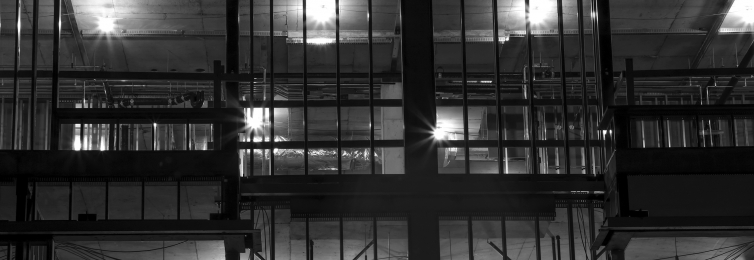Safety hazards can lurk anywhere, especially in the dark. That’s why a critical component of protecting construction crews and passersby is having proper lighting on the job.
In practice, illuminating a construction site is not as straightforward as it might seem. A mix of standards, lighting options, and outside conditions can make choosing and implementing the right lighting plan a challenge.
John Todd, a Risk Management Consultant with Builders Mutual, discusses what’s needed to bring a lighting plan out of the shadows.
What are common lighting challenges?
Insufficient light may be the most common – and troubling – type of lighting problem. If you can’t see a hazard in front of you, whether that’s a patch of ice or an oncoming excavator, you can’t avoid it. These challenges occur most often at night, when appropriate lighting becomes most important.
But poor lighting is hardly the only type of lighting challenge on the job-site. Others include:
- Glare. This can come from a bulb that is too bright, sunlight, or reflections from shiny surfaces. The brightness from excessive glare can affect how you see an object, and distort how close or far away it appears.
- Light distribution. If workers move across areas that are lit differently, they may need to adjust their vision so they don’t lose track of objects.
- Flicker. Lights that change rapidly can cause eye strain or headaches, or force workers to complete their tasks in an awkward position – all of which can be distracting and frustrating.
Safety is the top goal when lighting your job-site, but don’t forget about workers’ comfort. When your crew doesn’t have to strain their eyes from glare or flickering lights, they have higher satisfaction and productivity – and less churn.
How bright must your job-site be?
There’s no need to guess how much lighting to install on your job-site. OSHA has established minimum requirements for workplace lighting. These standards are expressed in the measurement of foot candles, which are defined as one lumen per square foot. A lumen is a measurement of visible light over a particular unit of time.
OSHA standard 1926.56(a) defines the following measurements for common construction environments:
- 3 lumens: General construction areas, concrete placement, excavation and waste areas, access ways, active storage areas, loading platforms, refueling, and field maintenance areas
- 5 lumens: General construction area lighting; indoors, including warehouses, corridors, hallways, and exitways; most tunnels, shafts, and general underground work areas
- 10 lumens: General construction plants and shops
What can be used to light my workplace?
When considering lighting options, make sure they align with the tasks at hand. Flood lights may be ideal for illuminating large areas, but if a worker needs to perform a task in a confined area, a headlamp may be better suited for the job.
Check out these fixtures:
- Light towers, the most common choice on construction sites, are portable and can cover a wide area using an adjustable mast that can reach as high as 30 feet.
- High mast lights are semi-permanent installations featuring a light pole that supports four to eight lights covering a large area.
- Balloon lights are often used in nighttime road construction zones. Roughly the shape of a balloon, these lights have covers made of a translucent material that diffuse the light across a work area.
- LED lighting is longer-lasting than standard CFL lighting, saving energy, material, and labor. LEDs can produced colored light and be mounted on equipment, such as pavers, which is particularly helpful for nighttime work.
If you’re using light towers, follow these safety tips:
- Position towers in the right direction., Tilting the lighting fixtures of the towers slightly downward angle will make sure their light won’t interfere with passersby’s vision and better illuminate the site for workers.
- Avoid indoor use: Operating light towers that run on diesel fuel exposes workers to toxic exhaust fumes.
- Refuel safely: Turn off the engines of diesel-powered models before filling the tank.
Make a plan – but don’t necessarily stick to it
Before beginning a new job, establish a lighting plan that includes areas to be lit, tasks that require specific lighting needs, and equipment to rent or purchase. Make sure this plan covers all of your subcontractors, too.
Now the important part: observe your plan in action. Changing environmental conditions and unforeseen tasks could necessitate new equipment or different positioning. Be proactive in altering your original plan to help avoid worker injuries.
If you need help creating a light plan, a number of resources exist to guide you, including the OSHA standards. If you’re lighting a roadside construction zone at night, first check out the comprehensive guidelines from the National Cooperative Highway Research Program. Specialized road lighting consultants can also be hired to tailor your lighting plans.
Builders Mutual risk management consultants can review lighting and safety plans, conduct job-site observations, and help you identify the right resources and solutions for your lighting needs.
Contact your risk management consultant today to shine a light on better job-site safety.




 Find an
Find an